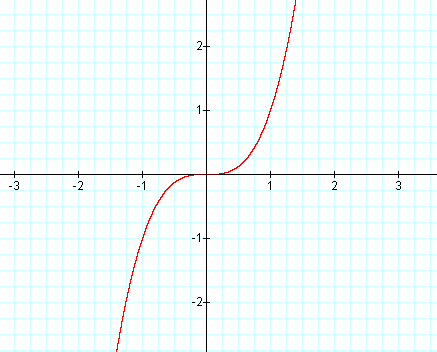
Draw the graph of
Answer
495.9k+ views
Hint: In order to draw the graph for any equation we need to find the local maxima and local minima and where it touches the x-axis and y-axis. Also take some sets of (x,y) by taking x as(-2,-1,0,1,2) to see how a certain graph is going up or down and also find the inflection points.
Complete step-by-step solution:
Given that the graph is
So let us find the values of local minima and maxima of the function
We know that for a point to be a local maxima or local minima
Which implies
but
This says that there are no local minima or local maxima for the given function.
From the function
At x=0 we got to know that both
let us take some sets of the given function
They will be
So the graph will be as shown below

Note: Don't just plot a few points and think you have the graph. Find all the things related to a graph which can change the certainty of the graph like inflection points local maxima and local minima and the intervals where the graph will be increasing or decreasing and so on…
Complete step-by-step solution:
Given that the graph is
So let us find the values of local minima and maxima of the function
We know that for a point to be a local maxima or local minima
Which implies
but
This says that there are no local minima or local maxima for the given function.
From the function
At x=0 we got to know that both
let us take some sets of the given function
They will be
So the graph will be as shown below

Note: Don't just plot a few points and think you have the graph. Find all the things related to a graph which can change the certainty of the graph like inflection points local maxima and local minima and the intervals where the graph will be increasing or decreasing and so on…
Latest Vedantu courses for you
Grade 11 Science PCM | CBSE | SCHOOL | English
CBSE (2025-26)
School Full course for CBSE students
₹41,848 per year
EMI starts from ₹3,487.34 per month
Recently Updated Pages
Master Class 11 Economics: Engaging Questions & Answers for Success

Master Class 11 Business Studies: Engaging Questions & Answers for Success

Master Class 11 Accountancy: Engaging Questions & Answers for Success

Master Class 11 English: Engaging Questions & Answers for Success

Master Class 11 Computer Science: Engaging Questions & Answers for Success

Master Class 11 Maths: Engaging Questions & Answers for Success

Trending doubts
State and prove Bernoullis theorem class 11 physics CBSE

1 ton equals to A 100 kg B 1000 kg C 10 kg D 10000 class 11 physics CBSE

State the laws of reflection of light

One Metric ton is equal to kg A 10000 B 1000 C 100 class 11 physics CBSE

1 Quintal is equal to a 110 kg b 10 kg c 100kg d 1000 class 11 physics CBSE

Difference Between Prokaryotic Cells and Eukaryotic Cells




